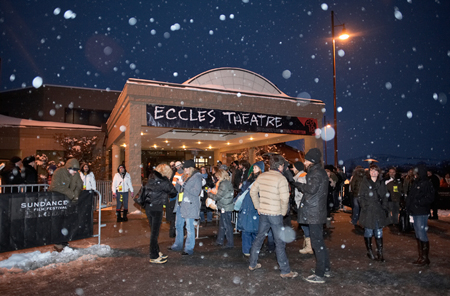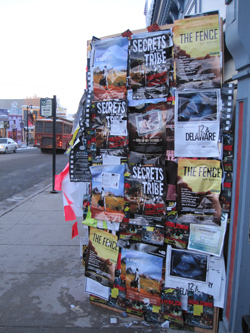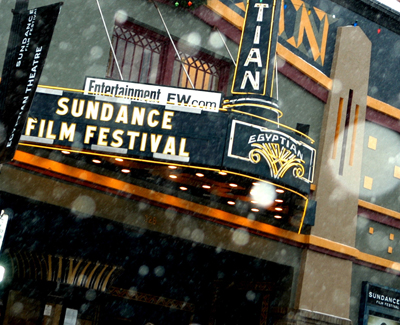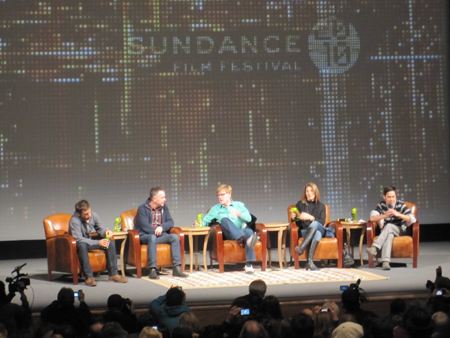The Sundance Film Festival is not only a showcase for the best of new independent cinema, it's also a rollercoaster ride through some of the planet's most exciting and hidden stories. If the picture that emerged from the 26th festival is to be believed, the end of the world is very nigh. The vast majority of the festival's 186 films - or at least the 38 features and 10 shorts that this correspondent viewed - suggest we are all hurtling towards Armageddon.
When the festival was founded in 1978, it was known as the US Film Festival, and American angst has always been the main subject of its films. This year, America's two wars take center stage. The opening night film and winner of the Grand Prize for Best Documentary was Restrepo, about a platoon of young, uneducated and mainly non-white soldiers stationed in Afghanistan's deadly Korengal valley. The directors were Sebastian Junger, author of The Perfect Storm, and British photographer Tim Hetherington. They spent 15 months observing the usually tedious, occasionally terrifying, reality of war. With no commentary, music, expert interviews, or political agenda, the film focuses on the visceral experiences of the soldiers, inspiring both admiration for their courage, and distress at the futility of their mission.

The tragedy of war also underlies The Tillman Story, a documentary about an American football star who enlisted in the US army after 9/11, and who was shot to death in Afghanistan. Military officials initially reported that he had perished in a heroic firefight with the Taliban. But Tillman's family later discover that it was his fellow soldiers who had negligently shot and killed him. Senior US officials - including Defense Secretary Donald Rumsfeld - are accused of trying to use Tillman's death as propaganda to shore up support for their unpopular wars. This engaging and sober film not only reveals how truth is the first casualty of war; it also shows a lust for gun-fighting as a major motive for many young enlistees.
The origins of the wars are explored in The Shock Doctrine, co-directed by Brits Michael Winterbottom and Mat Whitecross. They harness a lecture tour by author and left-wing activist Naomi Klein to suggest that mysterious American agencies of power have perpetrated a campaign of subjugation, starting in the 1950s with electro-shock therapy, similar to that used by Nurse Ratchett in One Flew over the Cuckoo's Nest. The film then links this to the the economic shock tactics of Milton Friedman, whose policies of disaster capitalism were adopted by Ronald Reagan, Margaret Thatcher, the IMF, Boris Yeltsin, Pinochet et al, to serve the interests of the elite. Klein and the filmmakers suggest that these 'free-market' policies led directly to the current economic malaise. The ultimate shock has been the use of military force, from the CIA-sponsored bombing of Salvador Allende, to the disappearances in Argentina, the use of the Falklands war to distract British voters from domestic troubles, right up shock and awe in Iraq. The result of all this shock is that leaders can avoid practising democracy, the rich corporations can get richer, and the people become alienated.
In a post-screening interview, festival founder Robert Redford praised the work: "I've never seen a film with such a long thread... It shows that what's really driving things is the connection between power and money." He went on to describe how this theme resonates in his own work. "Fear is in a lot of my story telling. In Three days of the Condor, there's the fear that something mysterious is out to kill my character [a CIA agent]. It's there as a backdrop in All the President's Men. In my film about quiz shows, there's the fear of losing ratings, which makes people be rabid and desperate. But I do believe that agit-propaganda does not work in film -the stories and characters are what matter."
Ironically, it is this very criterion that makes Shock Doctrine fail, for it is absolutely an agit-prop film, even more of a lecture than 2006 Sundance favourite, An Inconvenient Truth. Its story is a tendentious academic thesis, which, without any dissenting voices, has no conflict. Its characters - Klein standing behind a podium, and the filmmakers droning voice-overs, with a distinct lack of any dissenting voices - are dull and unconvincing.
A better portrait of US corruption emerges from Casino Jack and the United States of Money, directed by Alex Gibney, who won an Oscar for his 2007 exposé of the US military's use of torture, Taxi to the Dark Side. The film tells the story of lobbyist con-man Jack Abramoff to suggest that something is irremediably rotten in US government. Abramoff might have teamed up with dodgy Russians, and exploited American-Indian tribes, but congressmen from both parties all had their trotters in the trough.
Dark forces of US imperialist power re-appear in Bhutto, an excellent bio-pic of Benazir Bhutto that lays the blame for Pakistan's current, perilous situation at America's doorstep. The filmmakers suggest that Henry Kissinger started the country's corrosion when he rebuked Benazir's father, Zulfikhar Ali Bhutto, for not obeying US orders and threatened him with the words "we will make a horrible example of you." When General Zia toppled and executed Mr. Bhutto, Presidents Carter and Reagan continued to support Zia, not only striking a brutal blow to hopes of democracy, but also leading to Pakistan securing nuclear weapons. At the same time, the University of Nebraska was printing the textbooks used in political madrasas, which helped to radicalize Islamic factions. When the US abandoned Afghanistan in the wake of the Soviets' withdrawal, a vacuum was left that inspired radical jihadists to form Al Qaeda cells in Pakistan. Those same militant elements may have been behind Bhutto's December 2007 assassination, for which the filmmakers apportion further blame to the US because they did not pressure President Musharraf to provide security for Bhutto.
The yanks get even more spanked for the government's behaviour at home. Most scathing is the indictment of the state-funded education system meted out by Davis Guggenheim whose 2006 film An Inconvenient Truth won him an Oscar. Waiting for Superman, which won the Audience Award for Best US Documentary, paints a bleak picture of the "drop out factories" that most American children have to endure. Heart-rending was the footage of the film's four young subjects watching an actual public lottery - staged World Cup style with rolling balls in a wire cage - to see whether they would be accepted into a decent school. The stakes couldn't be higher: if their number doesn't come up, they will have no choice but to attend a school infested with incompetent, tenured teachers who cannot be fired because of the power of the teachers' unions.
The lottery ball, a powerful metaphor for the American Dream itself, re-appears in Lucky, directed by Jeffrey Blitz, who was previously responsible for Spellbound, the gripping documentary about children's spelling competitions. The film investigates why Americans spend more on lottery tickets -- $62bn a year - than they do on going to the movies -- $10bn a year - or on any other form of entertainment. It interviews lottery players, including one blue-collar employee at a car factory whose addiction means that she spends $70 a day on the fantasy that one day a jackpot - and the hand of God -- will elevate her from her financial suffering. It also explores the lottery winners, and how their windfall has affected their lives. Some of them were living the dream, reveling in marbled mansions in Florida with three Ferraris; or building a house for 50 extended family members back in native Vietnam. But most winners end up viewing their riches as a curse. They lose friendships to envy, and suffer crises in their sense of self. "Winning the lottery is like throwing Miracle-Gro on all your character defects," commented one contributor. Another tragic victor suffered murder attempts by all three of his siblings, before he squandered all his winnings, ending up in total destitution.
His economic distress is shared by millions of Americans, which last year prompted the film critic A. O. Scott to call on filmmakers to tell stories of race, class and poverty in a 'neo neo-realist' way. "The benign faith that dreams will come true can be hard to distinguish from the more sinister seduction of believing in lies," he wrote. "To counter the tyranny of fantasy entrenched on Wall Street and in Washington as well as in Hollywood, it seems possible that engagement with the world as it is might reassert itself as an aesthetic strategy. Perhaps it would be worth considering that what we need from movies, in the face of a dismaying and confusing real world, is realism."

So too does the festival's most emotionally disturbing film, Blue Valentine. Remember your worst ever relationship? Yes, the one that took you years to recover from, the one that made you think that love was a total fraud and waste of time? Now you can live the suffering again! Blue Valentine is an anatomy of a relationship between a removal-man-cum-housepainter Dean (Ryan Gosling) and an aspiring medical student Cindy (Michelle Williams), interweaving their joyful courtship with their acrimonious married life seven years later. Cinematographer Andrij Parekh ingeniously contrasts the two periods by shooting their happy days on nostalgic 16mm film using short lenses, and then shift to the Red HD camera on a voyeuristic long lens to frame the marriage's disintegration. The performances are complex and alive, and Gosling's portrait of a lost American anti-hero establishes him as an actor with comparable talent to Sean Penn. Its story is the loss of love - how joy and generosity between two people can descend into contempt. A key scene takes place soon after they meet, when handsome, charming Dean challenges the wary Cindy to prove she has a sense of humor. She replies with a story: A pedophile is walking into a dark wood with a ten year old boy. Deep inside the wood, the boy says. "Mister, these woods are really scary!" The man replies: "You're scared, son? I'm the one who has to walk out of here alone." The ensuing laughter from Gosling - and the audience -- solidifies Williams' superiority in the relationship, establishing that not only does she have wit, but that she understands the sick and twisted nature of society better than Gosling. Combined with his lack of ambition and unwavering adoration for her, the path to contempt and separation becomes inevitable.
Like Dean, pathetic men popped up on several Park City screens, many of them continuing the recent tradition of 'mumblecore', a form characterized by inarticulate, unshaven dudes grossing each other out. Directors of these films have leaped on the male misery bandwagon to create schadenfreude porn. I struggled through Douchebag about two brothers tragicomically incapable of communicating with, or committing to, the opposite sex. After the opening sequence of One too many mornings -- a young man repeatedly vomiting into a toilet - I walked out of the theater. I headed to see Welcome to the Rileys, in the hope that its stars James Gandolfini (aka Tony Soprano) and Kristen Stewart (Bella Swan in Twilight), and the directorial debut of Ridley Scott's son Jake might provide some relief. No such joy. Masculinity was even more in crisis here, with long scenes of Gandolfini weeping unconvincingly as first his teenage daughter dies, then his mistress dies, and then he is preposterously propelled to find solace in an underage stripper.
Adult dancing also pays the rent for Paz de la Huerta. In Enter the Void, she plays a young American woman who joins her brother Oscar in Tokyo, to escape the memory of a car-crash that killed their parents. Directed by visionary Franco-Argentine filmmaker Gaspar Noé, this poetic study of sex, death and sibling love is the only feature film that, on a stylistic and technical level, truly delivered on the festival's promise to wage "a recharged fight against the establishment of the expected." Much of it is shot from the point of view of Oscar, a small-time drug dealer, whose hallucinations Noé and his cinematographer Benoît Debie visualize with breathtaking skill. The loneliness of being an ex-pat in Tokyo has echoes of Lost in Translation; the nightmarish dystopia of strip clubs and back-alleys have kinship with David Lynch; and the cinematic realization of a bad trip are reminiscent of Requiem for a Dream. But Noé and Debie are truly original film masters. The scene transitions through a dizzying range of portals - bullet wound, gas hob, fetus, vagina, flames, urethra - and the crane-shots over the shadowy roof-scapes of Tokyo are a sensory experience even more overwhelming and ground-breaking than Avatar.
Alienation from society was a running theme of the festival. Life 2.0 is a documentary about the virtual reality world of Second Life, where some 18 million users relate to each other through avatars. The film follows a couple starting a new love affair that unwinds in a similar pattern to that of Blue Valentine; and various lonely individuals who spend up to 20 hours a day living out their fantasies. If only Second Life had been embraced by the festival's greatest train-wreck of a character: John (Daniel London) from the film Armless. John is a man so alienated from himself that he sets out to cut off his arms with a power-saw and achieve the perfect "nubbins" he once imagined he saw on a Vietnam veteran.
If they weren't senseless losers, Sundance leading men were savage sociopaths. Hesher portrays an anarchist loner who enjoys blowing things up. He's played by a tattooed, unwashed Joseph Gordon-Levitt, a diametrically opposed image of manhood to the sweet romantic he gave us in last year's chick flick (500) Days of Summer. The nastiest thug was in the most controversial film of the festival, The Killer Inside me, the second movie in the festival directed by Michael Winterbottom. Based on the 1952 pulp novel by Jim Thompson, the story is told through the disturbed eyes of Lou Ford (a sparkly, hardboiled Casey Affleck), a sheriff in a small Texas town, who enters into an S&M relationship with a prostitute (a luminous Jessica Alba). Spanking turns to choking in an atmosphere of erotic danger that evokes other classic noirs like The Last Seduction and LA Confidential. It's the scene where Affleck punches Alba's face to pulp while both are whispering 'I love you' that has been drawing most attention. One outraged woman stood up at the premiere and shouted, 'How dare you program this, Sundance!' The film certainly won't be making any Feminist Top Ten lists, but then neither did the novel. Stanley Kubrick, for whom Thompson wrote Paths of Glory and The Killer, once called it "the most chilling and believable first-person story of a criminally warped mind I have ever encountered".

Redford believes that redemption is possible. "Hope doesn't come from on high, it must come from below. Together, we filmmakers can make a difference. Sundance tells the truth about situations. Hopefully people can see these situations and collectively stop them happening again." That hope is present in a documentary about the threat of nuclear war, Countdown to Zero. Directed by Lucy Walker, a British ex-pat living in Los Angeles, it features interviews with Tony Blair, Henry Kissinger, Mikhail Gorbachev, and Robert McNamara, in the last interview before his death. They all call for the destruction of every nuclear weapon on earth. The problem is that the rest of the film reveals this to be a totally impossible dream. We learn that there are 23,000 nukes in the world (albeit down from 60,000 in their 1980s heyday), and that 40 more countries are pursuing the technology for a bomb. Uranium is more common than tin, and centrifuges are 1950s technology and dead easy to make. According to probability theory, the chance of a rogue bomb going off is precisely.... 100%. To make matters worse, we learn exactly how easy it is to make a nuke, and even get a run-down on all the ingredients and designs needed. "I didn't want to create a manual on how to make a bomb," Walker reassured me at a Filmmakers party after the screening. But if I were an aspiring jihadi, the experts in this film would be where I'd start for some free consultancy.
Back in the film, I started getting really nervous at an interview with Oleg Khinsagov, a Russian weapons smuggler, who reveals how to hide a weapon in a container of kitty litter and bring it into the US. "I had wanted to call the film How to Blow up New York," Walker admitted, "but the guys upstairs didn't like that." Effectively the creator of Dr Strangelove Redux - The Documentary, Walker does manage to include a scene about what a nuclear bomb would do to New York City, which Walker says the most likely place on the planet to be obliterated. It's also my home where I live with my 20 month old son. So forgive me if I was totally freaked out by the sequence that combined Times Square crowds counting down on New Year's eve with graphic imagery of the nuclear explosion's impact: winds of 650 mph, Manhattan vaporized, four million dead in one minute, exploding heads...
Get me out of this American Inferno!
Surely the rest of the world must have some light?
Happily, Sundance programmers had chosen films from 40 countries outside the US, allowing me take a world tour to recover from American cinema miserabilis. I started just outside Rio de Janeiro, in a place not known for its hope: the Jardin Gramacho, the world's largest landfill. This was the focus for Lucy Walker's other film, Waste Land, in which she follows Brazilian artist Vik Muniz as he collaborates with rubbish pickers who transform junk into art, charting a route out of poverty, and bolstering the recycling movement. With a stirring score by Moby, it's a heart-warming tale of human dignity and innovation, and was a worthy winner of the World Cinema Documentary Audience Award.
Another beacon of hope and winner, for the World Cinema Jury Prize for Documentaries, was The Red Chapel. This follows two Danish-Korean comedians, one of whom, Jacob Nossell, is, in his own determined definition, 'spastic', to put on a funny show in North Korea. Narrated by the show's director Mads Bruegger in a dry Werner Herzog-style voice, his strange project is based on the principle that "comedy is the soft spot of all dictatorships". His state aim is to expose "the most heartless and brutal totalitarian state ever created". Sacha Baron Cohen would have done a better job in satirizing Kim Jong Il, and we see scant evidence of the Dear Leader's brutality. But a scene in which wheelchair-bound Nossell is reluctantly pushed to the head of a massive anti-US rally, apparently to show the regime's sensitivity to the disabled, is hilariously stranger than fiction.
My native Britain had a small presence in the Sundance program. British actors were mostly in ex-pat mode. Tilda Swinton turned in a beautifully nuanced performance in Italian as an adulterous matriarch in I am Love, a sensual family drama set in Milan. There were numerous British directors, but their lenses were trained on subjects outside the country. Chris Morris was one exception, with a stunning directorial debut with Four Lions, the funniest satire of religious extremism since Life of Brian. There was also an LOL short, Can we talk?, about a young couple struggling to deal with the lady's distaste for what she tells her boyfriend are the "poo chunks on your bum hair." In the Q & A, the director Jim Owen illuminated us on the name for such unfortunate features of English lads' hygiene: "dangleberries."
The UK also co-produced the festival's most historically significant film, Enemies of the People. It portrays a Cambodian journalist, Thet Sambath, who has spent the last ten years, and all his savings, investigating the Khmer Rouge's slaughter of two million people, including his own parents and brother. Sambath persuades Pol Pot's right hand man, Nuon Chea, aka Brother Number 2, to tell his story for the first time. Other Khmer Rouge officials follow Chea's example, relating their reasons for taking part in the genocide: fear of disobeying orders and being branded an "enemy of the people", and a belief that the country was under threat. One of them, a Buddhist believer in reincarnation, explains that he is confessing in order to ensure a better place in his next life. The film culminates in a moving reconciliation between Chea and Sambath. Chea finally expresses regret, and was arrested two days after the interview. He now awaits trial for crimes against humanity. Meantime, Sambath says that he has found a way to forgive Chea and his accomplices: "not for being killers but for telling the truth."

There was little redemption on offer from my cinematic visits to other countries. I certainly won't be moving to Australia any time soon. Melbourne's criminal underworld, on display in Animal Kingdom, which won the World Cinema Jury Prize for Drama, makes Tony Soprano's New Jersey look like Sesame Street. Even more unappetizing an image of Oz comes from Cane Toads: The Conquest. Its background is the introduction of toads from Hawaii in 1935 to control a beetle infestation. In the absence of predators, the amphibians reproduced to become an Old Testament plague, with some 1.2bn toads estimated to be hopping around today's northern Australia. What makes the film unique is that it was shot and screened in digital 3-D, leading the film's director Mark Lewis to introduce the film with the words 'welcome to Ava-Toad!' I can vouch that you will never have seen anything like slimy beasts literally shagging in your face, nor will you have experienced the reconstructed hallucinations that dogs enjoy after licking a toad's belly.
Nummioq is also unique, as the first feature film to come out of Greenland. It's the story of a carpenter who learns he has terminal cancer and decides to take a last trip through an iceberg-studded fjord. The photography and music are lovely, but the material was so depressing that director Otto Rosing had a breakdown after finishing shooting, leaving screenwriter Toben Bech to assume the role of co-director and finish the film.
Greenland might be bleak, but nowhere near as close to the Hobbesian hell of Iraq. Son of Babylon begins in Kurdistan two weeks after the fall of Saddam Hussein, and follows a 12 year old boy and his grandmother, searching for the boy's missing father. Like an Iraqi version of The Road, they travel through the apocalyptic country, from smoking Baghdad to windswept shells of prisons in Babylon, hoping that the newly unearthed mass graves will yield the father's remains and give them closure. Their desperation grows, as we discover that in the last 40 years some 1.5 million Iraqis have gone missing, with only a few hundred thousand bodies ever identified.
On my last morning at the festival, I met the festival director John Cooper, who was hosting a Pancake brunch. I asked him as he was pouring batter why Sundance was the Francis Bacon of film festivals. He said: "The films are very dark because most are made by young people who are more attracted to darkness." I replied: "Isn't that counter-intuitive? Don't people get more morbid as they get older and closer to death?" Cooper said: "I've gotten more optimistic as I get older. If I ever get depressed, I just watch Grey Gardens [a documentary by the Maysles brothers] -- those women are such a mess, they make me feel better. Movies only give me nightmares if they have bugs in them."
So if any budding filmmakers interested in getting into Sundance 2011 are reading this, there's your secret, high-concept premise: bugs.
Sebastian Doggart is film maker, distributor and critic. His latest films, Courting Condi and American Faust: From Condi to Neo-Condi are screenable at www.indiesdirect.com

